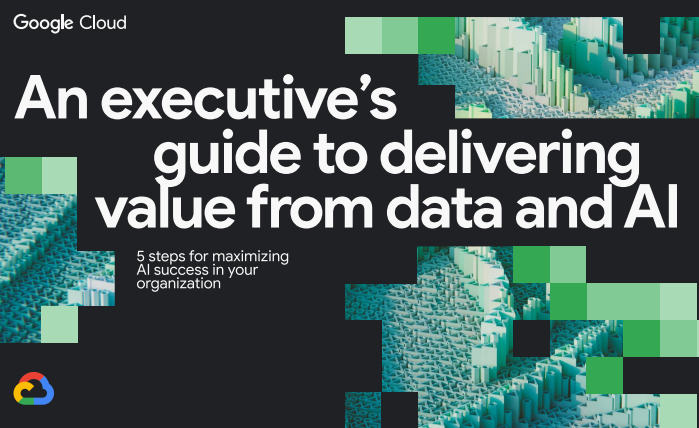Turning Data into a Strategic Asset: 5 Steps to Unlocking AI Value
Chief Growth Officer
Data is everywhere, but value from data? That’s another story. Executives today are under a lot of pressure to not just launch AI pilots but to scale them and deliver measurable results. And yet, many organizations quickly realize the biggest barrier to success isn’t the AI tools themselves. It’s in fact the data.

A closer look at An Executive’s Guide to Delivering Value from Data and AI
No matter where you look, you'll see opportunity to collect data. But turning that data into tangible value? That's the real challenge. Today's executives are under immense pressure not just to pilot AI initiatives but to scale them effectively and achieve measurable business outcomes. Yet, a common hurdle many organizations encounter isn't the AI tools themselves; it's the underlying data.
This fundamental insight forms the core of "An Executive's Guide to Delivering Value from Data and AI," a new resource from Google Cloud, now exclusively available through Gapps. The guide brings together insights from thousands of enterprise implementations and distills them into five key steps any organization can take to build a future-proof, AI-first data strategy.
From isolated pilots to production - scale AI
While generative AI promises incredible productivity gains, most businesses find themselves stuck in experimentation mode. According to Google Cloud’s own research, 70% of organizations adopting generative AI face roadblocks with data governance, data integration, and data readiness.
The guide’s central message is clear: the success of any AI initiative starts and ends with your data. Without the proper foundation, AI can’t scale, and the investments can’t deliver. If your organization is exploring how to operationalize AI and unlock its full business value, this is the guide for you.
Download now >
From data chaos to clarity – why culture matters?
The technology is only half the story. Many organizations assume that the right platform or tools alone will unlock the value of data and AI. But without the right data culture, even the best technology underperforms. The guide emphasizes the often-overlooked reality: data is everyone’s business. To truly become AI-ready, companies must foster a shared understanding of how data is used, owned, and valued across the organization. That means giving not just data scientists, but also marketers, product managers, and customer service teams the tools and skills to work confidently with data.
Creating an AI-first culture isn’t just about governance – it’s about building confidence, alignment, and momentum at every level. And that’s often where real transformation begins.
Unstructured data: the sleeping giant in AI strategy
If there's a silent killer of AI potential, it’s the 80% of enterprise data that goes unused: unstructured data. Think customer call transcripts, product documentation, images, PDFs, and handwritten notes. This information often holds the richest insights, but it’s the most difficult to access.
The guide dives deep into how organizations can begin to tap into this hidden goldmine by adopting multimodal AI strategies. That means treating all types of data, structured or not, as first-class citizens in your data platform. By converting these data types into formats AI can understand (like vector embeddings), businesses can unlock entirely new capabilities. For example:
- A support organization used chat logs to train models that now predict churn risk with high accuracy.
- A manufacturer indexed decades of maintenance logs to improve predictive maintenance across facilities.
- A retailer used product images and reviews to personalize search and improve conversion rates.
Unstructured data isn’t a challenge to work around. It’s a competitive advantage waiting to be claimed.
What you’ll find inside the guide
The free ebook outlines five essential steps to help organizations get the most out of their data and AI initiatives. Here's a preview:
1. Build an AI-first data strategy
Move beyond fragmented systems and design a strategy that treats data as a core business asset. Align it with your organization’s goals, from customer experience to cost efficiency.
2. Connect and unify your data
Break down silos and unify structured, semi-structured, and unstructured data across environments and formats. Establish a single source of truth that AI can act on, in real time.
3. Empower productivity with AI agents
Bring AI into daily workflows. From natural language querying to intelligent suggestions, integrated agents can help teams make faster, better decisions across the business.
4. Strengthen security and governance
AI without control is a risk. Ensure your platforms enforce strong data governance policies and compliance with evolving regulations, without slowing down innovation.
5. Optimize for scale and cost-efficiency
Modernize your data architecture to reduce operational overhead, storage costs, and compute waste. Adopt serverless, managed services that scale with your data and budget.
What success can look like
Organizations that take these steps are already seeing real business results. Here are a few examples of what’s possible to achieve:
- A global manufacturer unified data from hundreds of sources and cut query response times by over 50%, fueling faster insights for R&D teams.
- A major retailer embedded AI agents across operations, enabling teams to dynamically adjust inventory and personalize offers in real time.
- A digital platform connected millions of customer interactions to AI models, accelerating feature testing and driving more relevant user experiences.
These are just some of the ways businesses are turning data into a competitive advantage with the right foundation.
Why Google Cloud?
This transformation doesn’t happen in isolation. It requires a robust platform, and Google Cloud continues to lead the way.
In Forrester’s 2025 Wave for Data Management for Analytics, Google Cloud was named a leader thanks to its unified data platform, built-in AI capabilities, and unmatched scalability. With tools like BigQuery, AlloyDB, and Vertex AI, Google Cloud offers a data and AI stack that’s not only powerful but also proven.
From governance and real-time streaming to gen AI model development, Google Cloud provides the integration and openness modern organizations need to thrive in a hybrid, multicloud world.
Whether you're just starting your AI journey or looking to scale existing initiatives, this guide will help you focus on what matters most: your data.
Download the guide to learn how to:
- Build a scalable, AI-first data strategy
- Break down silos and unify your data
- Embed AI into everyday tasks
- Strengthen governance and control
- Scale efficiently while keeping costs in check
Get the Executive Guide to Delivering Value from Data and AI >>
AI’s promise is real, but it’s not magic. It takes strategy, structure, and a solid foundation to leverage its full potential. By putting your data at the center and choosing the right platform, you can go beyond pilots and start delivering real business outcomes.

-1.png)



